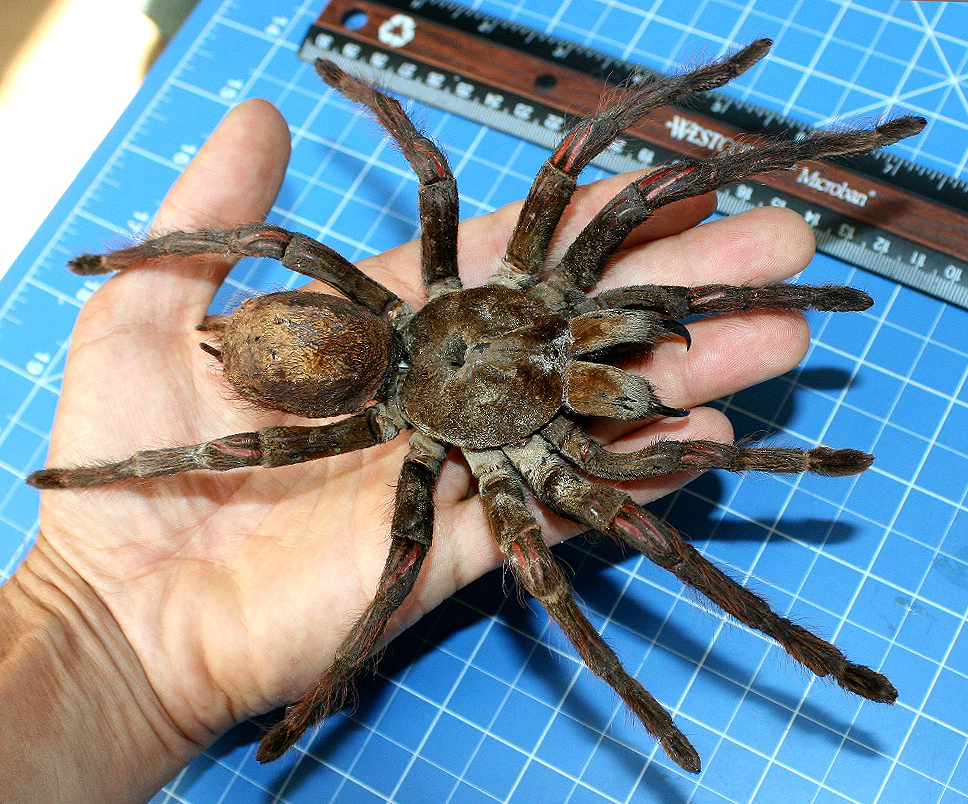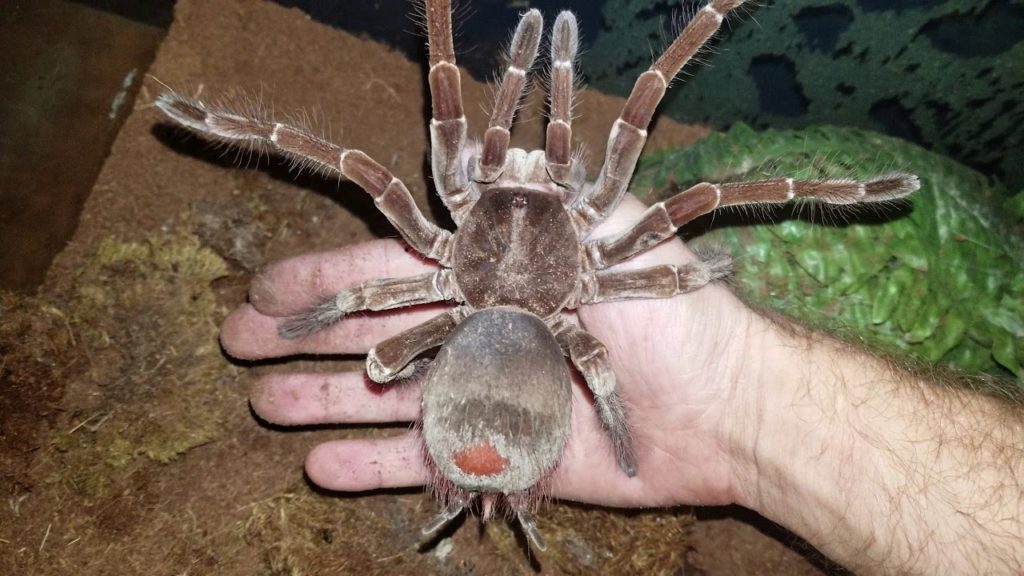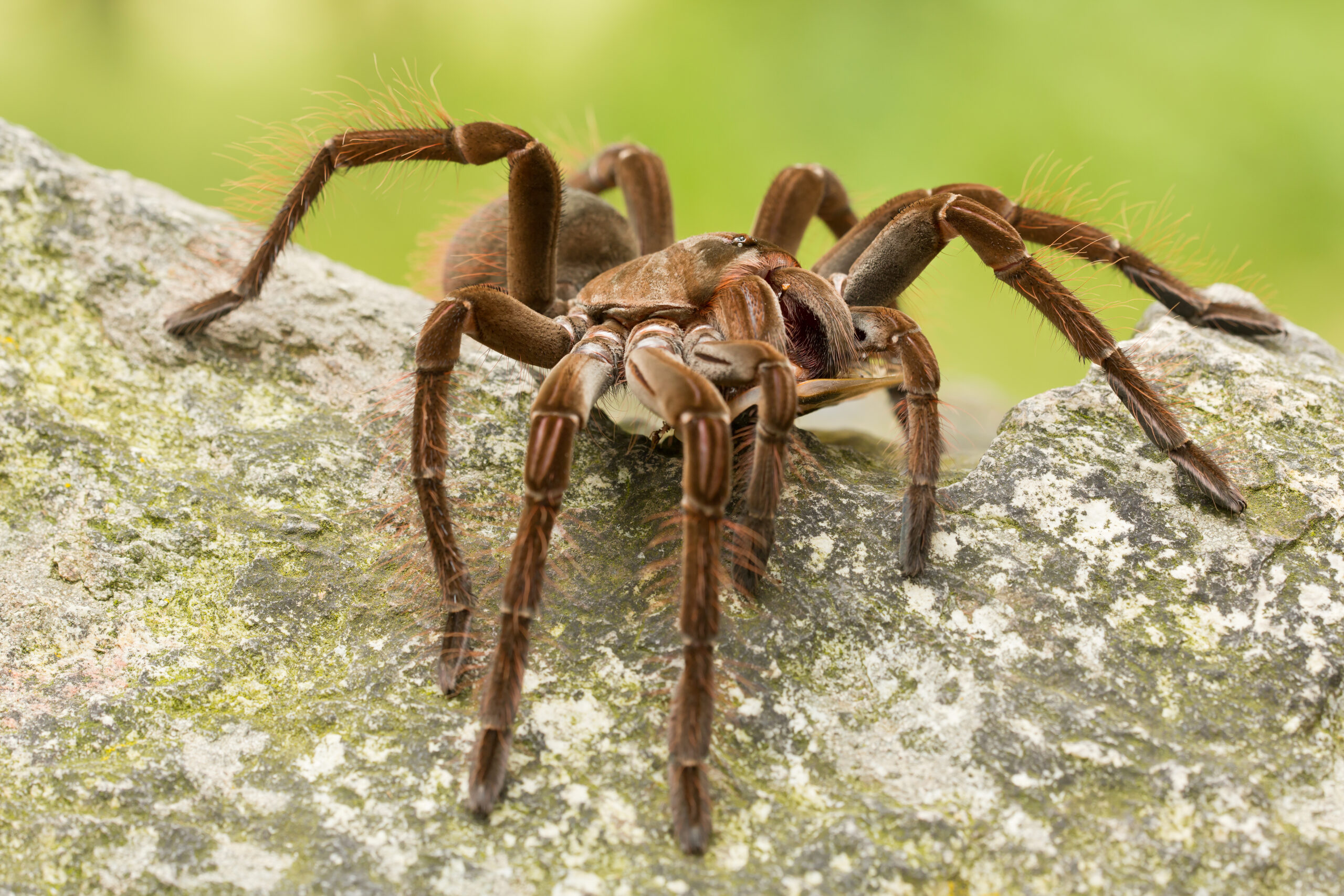Goliath Birdeater: Unveiling The World's Largest Spider
When you hear the name "Goliath Birdeater," it immediately conjures images of a monstrous arachnid preying on unsuspecting birds. While this giant tarantula, scientifically known as *Theraphosa blondi*, is indeed one of the most imposing spiders on Earth, its fearsome reputation often overshadows the fascinating reality of its existence. This article will delve deep into the world of the Goliath Birdeater, exploring its true size, its mysterious life in the rainforests of South America, its surprising diet, and the unique adaptations that make it such a remarkable creature.
Native to the dense Amazonian rainforests of northern South America, the Goliath Birdeater holds the impressive record for being the largest spider in the world by mass and body length. Despite its intimidating name, this superlative spider rarely eats birds, preferring a diet of insects and small rodents. Join us as we uncover the truths and dispel the myths surrounding this magnificent arachnid, revealing why it's not as scary as its name suggests and how it contributes to the intricate balance of its ecosystem.
Table of Contents
- The Goliath Birdeater: A True Giant Among Spiders
- Where the Goliath Birdeater Calls Home: Habitat and Distribution
- Life in the Rainforest: Behavior and Adaptations
- What's on the Menu? Diet and Feeding Habits
- Defense Mechanisms: More Than Just a Bite
- The Goliath Birdeater's Life Cycle: Molting and Longevity
- Is the Goliath Birdeater a Threat? Venom and Safety
- Cultural Significance and Conservation Efforts
The Goliath Birdeater: A True Giant Among Spiders
The name "Goliath Birdeater" often evokes a sense of awe and a touch of trepidation. This arachnid is indeed a titan in the spider world, and its sheer size is what initially captures most people's attention. It's certainly the largest we know of, and its name suggests as much, though the "birdeater" part is largely a misnomer, as we will explore later. The Goliath Birdeater holds the record for being the largest spider in the world by mass, making it a true heavyweight of the invertebrate kingdom.
Scientific Classification and Name
The Goliath Birdeater is scientifically known as *Theraphosa blondi*. It belongs to the tarantula family Theraphosidae, a group known for their often large, hairy bodies and impressive leg spans. This classification places it among many other fascinating tarantula species, but *Theraphosa blondi* stands out due to its unparalleled size. Understanding its scientific name helps us categorize and study this unique creature more effectively, moving beyond its common, somewhat misleading, moniker.
Unpacking Its Impressive Size
When we talk about the size of the Goliath Birdeater, we're not just talking about a slightly bigger spider. We're talking about an arachnid that can truly dwarf many other species. It is widely considered to be the largest known arachnid by mass, with individuals weighing in at over 6 ounces (175 grams). To put that into perspective, that's roughly the weight of a small puppy or a baseball! In terms of body length, the Goliath Birdeater can reach up to 5.1 inches (13 cm), which is about the size of an average human hand. When its legs are spread, these heavyweights can span up to 11 inches (28 cm), sometimes even reaching 12 inches (30 cm) across. While its leg span is second to the giant huntsman spider, the Goliath Birdeater remains the undisputed champion in terms of sheer body mass and length. It's truly a marvel of natural engineering, a living testament to the incredible diversity and scale of life on Earth.
Where the Goliath Birdeater Calls Home: Habitat and Distribution
The Goliath Birdeater is not just found anywhere; it has a very specific and demanding habitat that contributes to its unique characteristics. This giant tarantula lives exclusively in the rainforests of South America, specifically the Amazonian rainforests of northern South America. Its range stretches across several countries, including Venezuela, northern Brazil, Guyana, Suriname, and French Guiana. These dense, humid environments provide the perfect conditions for the Goliath Birdeater to thrive.
The rainforest floor, with its rich leaf litter, high humidity, and stable temperatures, is the ideal environment for this terrestrial spider. They prefer to live in burrows, often repurposing abandoned rodent burrows or digging their own. These burrows provide shelter from predators, a stable microclimate, and a perfect ambush point for unsuspecting prey. The specific environmental conditions of these rainforests are crucial for the Goliath Birdeater's survival, highlighting the delicate balance of ecosystems and the importance of preserving these vital habitats.
Life in the Rainforest: Behavior and Adaptations
The life of a Goliath Birdeater is one of quiet stealth and remarkable adaptation. Highly adapted to the dense and dark environment of the rainforest floor, these spiders exhibit behaviors that allow them to survive and flourish in their challenging habitat. Their existence is a testament to the power of natural selection, shaping creatures perfectly suited to their surroundings.
Solitary and Nocturnal Habits
The Goliath Birdeater is a solitary and nocturnal creature. This means that for most of its life, it lives alone, avoiding interaction with other spiders of its kind except during mating. Its nocturnal nature is a key adaptation; hunting at night allows it to avoid many diurnal predators and to capitalize on the activity of its prey, which are often more active after dark. During the day, the Goliath Birdeater typically remains hidden within its burrow, conserving energy and staying safe from the harsh sun and potential threats. This reclusive lifestyle is common among many tarantula species and underscores their role as ambush predators rather than active hunters that chase down their prey.
What's on the Menu? Diet and Feeding Habits
Despite its common name, the Goliath Birdeater rarely eats birds. This is one of the biggest misconceptions surrounding this magnificent arachnid, and it's important to clarify. While it *can* prey on birds if the opportunity arises – particularly ground-dwelling nestlings or small, injured birds – its primary diet consists of a much wider range of prey that is more readily available on the rainforest floor.
The diet of the Goliath Birdeater primarily includes insects, such as crickets, beetles, and large cockroaches. They are also known to prey on other spiders, including smaller tarantulas. Beyond insects and other arachnids, their diet extends to small rodents like mice, frogs, lizards, and even small snakes. The Goliath Birdeater is an ambush predator; it waits patiently in or near its burrow for unsuspecting prey to pass by. Once an animal is within striking distance, the spider lunges, using its powerful fangs to inject venom. The venom paralyzes the prey, allowing the Goliath Birdeater to then suck its prey dry, liquefying the internal organs before consuming them. This method of feeding is typical for many spiders and highlights their efficiency as predators in their ecosystem.
Defense Mechanisms: More Than Just a Bite
While the Goliath Birdeater possesses a venomous bite, it's not its primary defense mechanism against perceived threats. Like many tarantulas, it has several unique ways to deter predators, making it a formidable creature even without resorting to its fangs. Understanding these defenses helps to demystify the spider and appreciate its complex adaptations.
Hissing and Urticating Hairs
One of the most striking defense mechanisms of the Goliath Birdeater is its ability to "hiss." This sound, known as stridulation, is produced by rubbing bristles on its legs together. It's an audible warning to potential threats, similar to the hiss of a snake, and can be surprisingly loud. This auditory deterrent is often enough to scare away many predators. Beyond stridulation, the Goliath Birdeater also has a special defense mechanism involving urticating hairs. These are tiny, barbed hairs located on its abdomen. When threatened, the spider can rub its hind legs against its abdomen, dislodging these hairs and flicking them towards the perceived danger. These hairs are incredibly irritating to skin and mucous membranes, causing itching, rashes, and discomfort. For predators, especially those with sensitive eyes or respiratory systems, these hairs can be a powerful deterrent. This combination of a vocal warning and irritating hairs means that the Goliath Birdeater often doesn't need to resort to biting, making its venomous bite a last resort rather than a first line of defense.
The Goliath Birdeater's Life Cycle: Molting and Longevity
The life cycle of the Goliath Birdeater, like other tarantulas, involves a fascinating process of growth and transformation, primarily through molting. As an arthropod, the Goliath Birdeater has an exoskeleton, a rigid outer shell that doesn't grow with the spider. To increase in size, the spider must shed its old exoskeleton, a process known as molting or ecdysis.
During molting, the spider will typically lie on its back, and its old skin will split, allowing the spider to slowly pull itself out. This is a vulnerable period for the Goliath Birdeater, as its new exoskeleton is soft and pliable, making it susceptible to predators. It can take several hours for the molting process to complete, and then several days for the new exoskeleton to harden. Younger spiders molt more frequently as they grow rapidly, while mature spiders molt less often. This process also allows the spider to regenerate lost limbs or repair minor injuries.
In terms of longevity, female Goliath Birdeaters can live for an impressive 15 to 25 years in captivity, and likely a similar duration in the wild, though precise data for wild lifespan is harder to obtain. Males, however, have a significantly shorter lifespan, typically only living for 3 to 6 years, often dying shortly after reaching sexual maturity and mating. This disparity in lifespan is common among many spider species and is linked to the males' primary biological role of reproduction.
Is the Goliath Birdeater a Threat? Venom and Safety
Given its imposing size and common name, many people wonder about the danger posed by the Goliath Birdeater's venomous bite. While it does possess venom, it's important to understand its potency and the typical reaction to it. The venom of the Goliath Birdeater is not considered life-threatening to humans. Its bite is comparable to a wasp or bee sting in terms of pain and effect. Symptoms typically include localized pain, swelling, and redness at the bite site. Allergic reactions, while possible, are rare, similar to reactions to other insect stings.
The Goliath Birdeater uses its venom primarily to paralyze and digest its prey, not as a potent defense against large animals like humans. As discussed, its first line of defense involves stridulation (hissing) and flicking urticating hairs. A bite is usually a last resort, employed only if the spider feels cornered or severely threatened. For humans, the main concern from a Goliath Birdeater encounter would likely be the irritation from its urticating hairs, which can cause significant itching and discomfort, especially if they get into the eyes or respiratory system. Therefore, while respect for its size and natural defenses is warranted, the Goliath Birdeater is not the deadly monster its name might imply.
Cultural Significance and Conservation Efforts
The Goliath Birdeater holds a unique place in both scientific and cultural contexts. Scientifically, it's a subject of immense interest due to its record-breaking size, unique adaptations, and its role as a top predator in its specific niche. Researchers study its behavior, life cycle, and venom to better understand arachnid biology and ecology. Its very existence challenges our perceptions of what a spider can be, pushing the boundaries of known arachnid dimensions.
Culturally, the Goliath Birdeater often features in discussions about extreme wildlife, embodying the awe and fear that large, mysterious creatures from remote rainforests can inspire. It's a popular attraction in zoos and conservation centers worldwide, including institutions like the Smithsonian's National Zoo in Washington D.C. The zoo, always free of charge, instills a lifelong commitment to conservation through engaging experiences with animals and the people working to save them. Seeing a Goliath Birdeater up close allows visitors to appreciate its scale and learn about its true nature, dispelling myths and fostering respect for these often-misunderstood creatures.
While the Goliath Birdeater is not currently listed as endangered by major conservation organizations, its habitat—the Amazonian rainforest—faces significant threats from deforestation, agriculture, and climate change. Protecting these vast and biodiverse ecosystems is crucial for the survival of the Goliath Birdeater and countless other species. Conservation efforts focused on preserving the Amazon indirectly benefit this giant tarantula, ensuring that future generations can continue to discover its characteristics and marvel at its unique place in the natural world.
The Goliath Birdeater is more than just a large spider; it's a symbol of the incredible biodiversity of our planet and a reminder of the hidden wonders that still exist in its most remote corners. Its scientific and cultural interest serves as a powerful argument for the continued protection of its natural habitat.
In conclusion, the Goliath Birdeater, *Theraphosa blondi*, is an extraordinary arachnid that truly lives up to its "Goliath" moniker in terms of size and mass. Found exclusively in the Amazonian rainforests of northern South America, this solitary and nocturnal creature is a master of its environment, employing unique defense mechanisms like stridulation and urticating hairs rather than relying solely on its venomous bite. Despite its intimidating name, its diet primarily consists of insects and small vertebrates, rarely birds. Understanding its true nature helps us appreciate its vital role in the ecosystem and the importance of conserving its precious habitat. So, the next time you hear about the Goliath Birdeater, remember that this impressive spider is a marvel of nature, far more fascinating than frightful.
What are your thoughts on the Goliath Birdeater? Have you ever seen one in person, perhaps at a zoo like the Smithsonian's National Zoo? Share your experiences and perspectives in the comments below! If you found this article insightful, please consider sharing it with friends and family who might also be fascinated by the world's largest spider. You can also explore other articles on our site to learn more about the incredible diversity of life on Earth.

Goliath Birdeater – Theraphosa blondi LATREILLE, 1804 – Wonderful-Insects

Meet the f***en Goliath Birdeater, largest tarantula in the world

Goliath Birdeater – The Lawrence Hall of Science